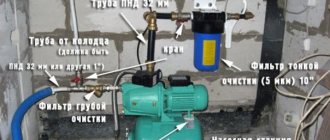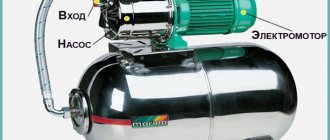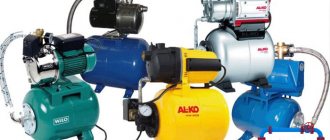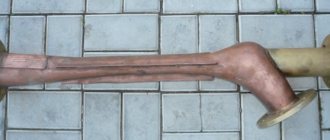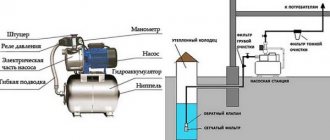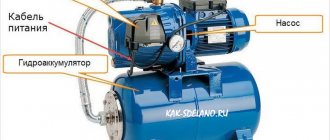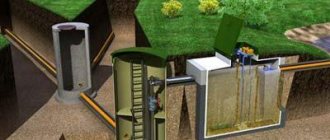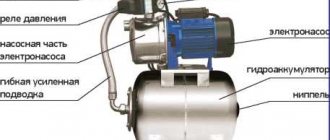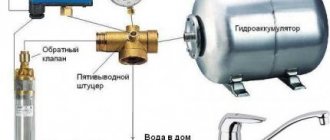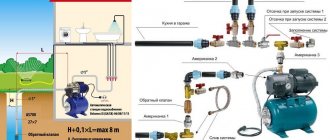A pumping station is a complex of components and assemblies located on the surface or in a building, interconnected, providing constant pressure and water supply to plumbing fixtures.
The equipment is constantly in working order, even if the flow of liquid is stopped. Seconds pass between the standby mode and the immediate activation of the device. Of course, this manner of operation can lead to breakdown of the main components, which will require repair of the pumping stations.
The pump pumps jerkily, turns on and off very often
To fix this problem, you need to do the following:
Pay attention to the pressure gauge, which is located on the automation unit. If the pressure gauge needle rises to the pressure at which the station was set (the pump will turn off), then drops sharply until it turns on, then there may be the following reasons: there is no air pressure in the hydraulic tank
At the factory, nitrogen is pumped into the tank to a pressure of 1.5 atm. Sometimes, due to corrosion, cracks appear in the tank body and the pressure does not hold for long. You need to find the leak and seal the crack (for example, “cold welding”). You can check the air pressure in the hydraulic tank by connecting a pressure gauge (at least a car gauge) to the nipple. The pressure in the tank may not necessarily be due to a crack, but simply due to unknown reasons, the air has escaped. Then you don’t need to drive yourself crazy in search of non-existent cracks, but simply pump up the air with a pump (in fact, that’s where you should start); rupture of the diaphragm separating air and water in the tank. You can check this through the nipple: if water flows from the nipple, it means the diaphragm is damaged; The pressure switch does not work. which controls the activation of the pump.
Problems with the membrane or pressure in the accumulator
The membrane is made of dense rubber. There could be two problems here:
- the rubber has burst and needs to be replaced;
- the pressure in the hydraulic accumulator is less than required - the rubber was subjected to excessive stretching for a long time and eventually failed.
If you press on the nipple, which is located under the plastic cover, water will flow out. This is a clear sign that the rubber has lost its integrity and the membrane will have to be changed, or the attachment point to the battery has become leaky, or the spool needs to be replaced.
The membrane can be purchased at a store in the pumping equipment department or ordered at a service center. If you need to increase the pressure in the accumulator, use a regular bicycle pump. The upper pressure that the pressure gauge shows is the sum of the water pressure in the membrane and the air pressure in the membrane tank. Together they show, for example, 2.9 atmospheres. Of this, 0.8 atmospheres will be air. While observing the pressure gauge readings with the equipment turned off, you need to pump air into the accumulator.
The relay will not switch if there are cracks in the membrane tank housing. Plastic is not the best solution for devices that need to work for a long time. If there are cracks, it is necessary to disassemble the pumping station, disconnect the tank and reassemble everything in the reverse order.
The pump does not draw water
When it is discovered that the pump does not pump water, one of the reasons may be that the pressure in it is not adjusted correctly. Elimination of the problem is carried out according to the following scheme:
- the pumping station is switched off from the electrical network;
- water is drained from the water tank;
- the air pressure in the tank is measured through the nipple using a car pump with a pressure gauge or compressor, its optimal value is 90-95%;
- air is pumped into the water supply system.
- water is poured into the station;
- connects to a network with pressure control.
The air in the water supply system is pumped as follows. The cover from the pressure switch is removed by removing the plastic screw and changing the tightening force of the existing springs of the unit. By turning one nut, the lower pump value is turned on. Clockwise rotation causes the pressure to increase, while counterclockwise rotation causes the pressure to decrease.
Turning the other nut adjusts the pressure range between the lower and upper limits. The range boundaries are changed by rotating the element clockwise to expand, counterclockwise to decrease it. After the steps have been completed, the pumping station is connected to the electrical network and its functionality is checked.
Collector.
Broke despite all precautions.
“Well, what’s special about it?” - you ask, and you will be absolutely right. Nothing, collector and collector. It’s only after many years of operation of the station in unfavorable conditions that all threaded connections turn sour. Where is your pumping station? At best, in the kitchen, but usually in the bathroom, in the corridor (in the hallway), in the basement, at the top of the well, in the well itself, in the bathhouse, in the boiler room, etc. And even after treatment with a “liquid wrench”, it is not always possible to quickly and painlessly remove a pressure gauge or pressure switch, given the small size of the thread. Therefore, I just urge you to be careful, if possible, do not remove or replace them. Well, if anything... you’ll have to look for a “manifold for a pumping station” in the store.
I won’t write anything about the bypass pipe Pipe and pipe. Typically, this is a flexible liner of larger or smaller diameter. If the station is dispersed (for example, based on a deep-well pump), then it is simply a pipe between the pump and the hydraulic accumulator. Again, it’s usually the connections that break, not the pipes. But if you have questions, ask, I will answer with pleasure.
All that remains after the frosty winter.
You'll get some good sandpaper.
And now, especially for summer residents.
Common causes of pumping station breakdowns
In the world, as the classics rightly say, nothing lasts forever, this also applies to equipment. Unexpected malfunctions in the operation of pumping equipment; its stop or incorrect operation can be caused by a number of reasons, such as:
- lack of electricity;
- lack of water in the system;
- pump failure;
- breakdown of the membrane tank;
- damage to the automatic unit, etc.
The design of household pumping units is not particularly complicated, and this allows you to do the repairs yourself. In some cases, you need to disassemble the pump and replace the damaged part. Sometimes it is necessary to seal a crack in the tank, and sometimes it is enough to simply check the availability of electricity. In each specific case, you need to determine why the pump does not pump water and find a “recipe” for solving the problem. If you cannot find an acceptable solution to the problem, you need to contact specialists.
Solving problems associated with the lack of water in the system
The first step is to check the tightness of the pipelines and the presence of water in the system. When there is no water, the cause could be a malfunction of the check valve located between the head of the well and the inlet pipe of the pumping station. This part stops working as a result of the valve becoming clogged with foreign objects. The unsuitability of the spring that controls the operation of this element is also being considered.
A clogged valve can be eliminated by cleaning it after removal, and if it breaks, you need to completely replace the check valve, but this will require a significant amount of money. When the pumping station is idle for a long time, a situation arises when water disappears at the junction of the well and the pump. A special filling hole eliminates the problem.
If there is a problem with a seasonal decrease in water level, the solution is to place the pump inlet circuit deeper into the well shaft. When the inlet circuit is deeply immersed, the likelihood of clogging increases; to prevent this, a filter is installed.
Insufficient voltage in the network is also the reason for the lack of water flow when the supply system is running. This is determined by a power supply tester. Wear of pump blades can be eliminated according to the following plan:
- disassembling the pumping device using a special tool to facilitate removal;
- inspection of the condition of the impeller, if necessary, replacement of a broken blade;
- If it is impossible to replace a broken part (it all depends on the manufacturer), the pump is completely replaced.
The pump hums, but does not spin
The reasons for this pumping station malfunction are as follows:
- It happens that the pump spent the winter somewhere in a barn, and in the spring they took it out and tried to start it. But it begins to hum... Due to the fact that the pump was left without water and without movement for a long time, the pump impeller “glued” to the housing. You need to manually rotate the impeller from the back side, and then plug it into the network;
- the capacitor has failed (located in the branded engine box);
- It is necessary to check the voltage in the electrical network, perhaps it is simply too low.
That's all (or almost all) that can be said about malfunctions of the pumping station for water supply systems at home and about repairing the pumping station with your own hands.
pumping station malfunctions
2013-2017 Copyright Use of site materials is permitted with reference to vodoprovod-doma.ru
The pressure device turns on more often than usual
Why does a working pumping station often turn on? The reason is primitive - there is insufficient pressure in the air chamber of the storage tank. The lower the air pressure, the more often the pump turns on and the period of its continuous operation decreases. To make sure of this, take a car pressure gauge and measure the pressure on the nipple inserted into the tank. In many models of water-pressure installations, normal pressure is considered to be 1.5 Atm. If, after testing on the pressure gauge, it is 0.5 Atm or 0.9 Atm, using a conventional car pump, air is pumped into the tank to the recommended value.
It is worse if, when monitoring the pressure in the air compartment of the tank, its complete absence is discovered. This may be a consequence of air leakage through the rusted metal body of the tank, which may well occur after 3-4 years of operation if the tank is made of ordinary rusting steel. The leak will be detected when you try to inflate the air chamber. In many cases, the tank cannot be repaired, so you will have to replace it.
Currently, new storage tanks are sold as a set (tank, membrane fabric, connecting flange), thanks to which replacing it is not difficult. It is necessary to disconnect the nut of the pump pipe section from the old flange and release the two threaded fasteners connecting the tank with the devices installed on top
The used tank is carefully removed and a new one is placed in its place. The fasteners are tightened, a piece of pipe is attached to the new flange - the station is ready for work
What else could be causing the regular switching on of the equipment? This happens when a rubber bulb becomes unusable (breaks). It is easiest to diagnose such a malfunction - when you press the nipple, water actively flows out of it. In such a situation, it is necessary to change the “breathing” film. How to do this?
It is necessary to prepare containers (dishes) to drain the water (the tank is fully filled with liquid). First, the nut connecting the pipe section with the flange is loosened little by little so that water begins to flow. When the liquid has completely drained from the inlet, unscrew the bolts connecting the flange to the tank body and drain the remaining contents of the tank. Now you need to pull out the used “breathing” film, dry the tank as much as possible inside (if it is made of ordinary steel) and place a new bulb in it. The flange is installed in place, gradually bolted to the body, and a section of pipe is attached. Replacement of the rubber membrane fabric is complete. All that remains is to pump air through the nipple to the previously specified pressure and pour water into the pump cavity. You can turn it on.
Adjusting the pressure switch of the pumping station
The considered breakdowns of water pumping installations are considered very popular; they can be easily removed by the owners of the equipment themselves. Interruptions in operation are also possible due to problems with the automatic control system. This happens quite rarely and requires the intervention of a professional technician. It is better not to touch the relays and sensors with your own hands.
Hydraulic accumulator.
According to the design, it is an ordinary iron barrel with a rubber membrane inside, with a platform for attaching the pump and paws for attaching it. On one side there is a threaded outlet for supplying water, on the other there is a standard threaded fitting with a spool for pumping air, usually covered with a rubber or plastic cap. Well, what could happen to him?
Air connection.
Most often, over time, air is released from the air half of the HA. As a result, the GA becomes just an iron barrel, accumulating nothing. The pump turns on faster (it also turns off quickly) and more often. I once watched a pump turn on and off 8 times in one minute with the faucet tap fully open. Manufacturers allow no more than 2 times per minute. This disease is treated easily and quickly. Using any pump (automotive), we raise the pressure in the air half to half the maximum water pressure. Initially it was 1.5 bar, but for water it was initially set at 2.8-3.0 bar. Therefore, half is better, or, if you didn’t touch anything on the pressure switch, 1.5 bar.
Unfortunately, any other incident with GA is fatal for him. For example, rupture of the membrane (almost impossible, but I saw it once) or freezing (this is more common, usually among summer residents). I think it is unnecessary to remind that the air pressure in the HA should be checked and, if necessary, increased with the pump turned off and zero pressure at the head.
Principle of operation
The main difference between a pump and a pumping station is the automatic maintenance of water pressure in the central water supply system. The main factors that support the full operation of the pumping station are the availability of electricity and the required amount of water in the well.
Pumping station
Operating principle and design of a pump with a storage tank
A pumping station with a storage tank is considered an old model, although today such options are still found. The reason is that the tank itself is a very bulky structure. The presence of water and pressure in it is controlled by a float and when the level decreases, a sensor is triggered, starting its pumping. This system has a number of disadvantages:
1. Large dimensions;
2. If the water level sensor fails, water may overflow into the room;
3. Difficulty of installation;
4. Low pressure due to the fact that the water flows by gravity;
5. The tank must be installed above the station level.
Operating principle and design of a pump with a hydraulic accumulator
A pumping station with a hydraulic accumulator is considered the best option for autonomous water supply. Such a system contains a relay, through which the maximum air level is controlled. In this case, in the hydraulic accumulator it decreases in volume due to water pressure.
Once put into operation, the pumping station begins to draw water from the well and, due to pressure, sends it to the hydraulic accumulator. As soon as the user at home turns on the water, the pressure in the system gradually decreases. When the pressure drops to a certain level, the relay will turn on the pump, which will pump water into the container and thereby increase the pressure to the required level. The relay then turns off the pump. If the water demand is small, the pump itself will not turn on, so liquid from the tank will begin to flow into the tap.
General completeness
Regardless of the type of station - with a battery or with a tank, it is additionally equipped with:
1. Cable;
2. Pumping unit;
3. Pressure gauge;
4. Grounding terminals;
5. Diaphragm pressure tank;
6. Connector for connection.
Common faults and their solutions
The pump does not turn on
Check the correct connection and connection of the unit cable to the outlet or control panel. The equipment includes a special pressure control relay, which is responsible for the timely activation of the pump.
The cause of the malfunction may lie in incorrect adjustment of the pressure valve. By unscrewing the steering wheel completely, we reduce the pressure to 0. If we consume water in this state, the pump will not work, since it is already zero.
A device that has been standing for a long time may have oxidation of the contacts.
Does not turn off after stopping water intake
The check valve installed on the pipe is faulty. During operation, the unit draws water from a well or well and supplies it to the tank and water supply system. Fluid consumption stops and the pump turns off. The water remaining in the pipe goes into the well, where it hits a check valve.
Consequently, if the damper does not work, the water goes underground, a loss of pressure occurs and the station reacts with lightning speed, turning on the pump. The liquid rests against a closed plumbing fixture and falls again, creating the effect of a constantly running engine.
Replacing the valve may solve the problem.
Frequent pump activation
Indicates a faulty hydraulic accumulator. In normal operating mode, there is constant movement of water in the tank. The air membrane creates pressure, and the automation relay sends a signal to operate the pump motor. If the seal of the tank body or the pipe system itself is broken, a drop in pressure occurs. To reach the desired level, the pump is constantly turned on. The rubber bulb inside the accumulator may rupture and the water will begin to siphon.
It is possible to fix the problem only by completely replacing the expansion barrel.
Equipment shuts down frequently
The reason is that the nodes are not configured correctly. If power is supplied and the unit operates, but immediately turns off, then functions again, the pressure control relay is configured incorrectly.
In the sensor body, in addition to the pressure gauge and the power button, there are two steering wheels. The first regulates the upper cut-off threshold and the lower turn-on threshold of the pump. The second sets the work step. By rotating these two thumbs, you can independently adjust the torque of the wheel.
Water coming from the discharge pipe comes with air
The first cause of a malfunction is a violation of the tightness of the unit or devices associated with it. Proper operation of the pump ensures uninterrupted water supply to a private home from a well. The appearance of cracks or gaps in joints, joints or housing leads to an inevitable loss of tightness. The liquid will mix with air entering through the cracks.
The solution is to check and replace components that violate the integrity of the system.
The second reason is the lack of the required water level in the well. The hose supplying liquid from the shaft is located above the level and, along with it, constantly draws in the air formed inside the shaft.
The solution is to lower the hose.
The water flows in jerks, the flow is constantly interrupted
The mirror (column) in the well is constantly changing, sometimes rising, sometimes falling. This process depends on the correct calculation of the well flow rate. The power of the unit may be greater than the ability of the aquifer to fill the cavity. That is, five minutes of operation of the device completely drains the shaft, then a standby mode begins when the motor runs dry. During this time, the water rises again and is drawn into the hose.
The solution is to replace the pipe immersed in the well with a smaller diameter.
The pump hums, but the impeller does not rotate
A complex case that requires detailed diagnostics. The failure is most likely due to the inability of the motor to spin the wheel. This happens when the station has stood idle for a long time and the disk has become stuck or its edges have rusted.
The pumping station will need repairs. Having disassembled the cover hiding the impeller, it will become clear which unit has failed.
Another reason for this breakdown is considered to be wear and tear of electrical equipment. The braiding of the engine compartment overheated and the wires stuck together. Electricity is consumed, and therefore it hums, but the melted winding does not have enough strength to turn the shaft.
Read also: Gp ultra alkaline battery can be charged
The engine hums, the impeller rotates, but no water flows
The well is simply empty. The solution is to lower the hose to the level of the water horizon.
Depressurization of device compartments - check all joints and plugs.
The equipment power is incorrectly selected. Each station has its own characteristics. These include the pressure of water supplied from the well, the volume of the expansion tank, and the depth of liquid intake. Incorrectly selected equipment is the reason for its incorrect operation. Simply put, the pump cannot lift a column of liquid due to its low characteristics.
Solution - remove the hose from the well and lower it into a bucket of water. The station will pump it out in a matter of seconds, which means you need to change the equipment to more powerful one.
Strong vibration when the engine is on
The bearing on the rotary shaft of the electric motor has become loose or destroyed. You can diagnose the problem by disassembling the rear part of the motor and shaking the shaft. Replacement is made with a part similar in all respects.
Basic information about the operation of the pumping station
The pumping station operates according to the following scheme: receiving power from the source, the suction pump begins to draw water, the water goes into the tank, filling it to a certain level, after which the pressure switch stops the suction device. When a person consumes water, the liquid level in the membrane tank drops, the pressure switch gives the command to implement the water intake process again.
Usually, when purchasing a pumping station, the warranty period is indicated. What to do when the pump does not pump water after such a period has expired? There are certain approaches to performing work related to the failure of a station, allowing you to find the cause of the breakdown, and ways to repair the pumping station yourself. In many cases, this does not take as much time as it might seem at first glance.
Pressure gauge.
Feel the difference. On the right is a crushed pressure gauge.
Perhaps the most harmless device at a pumping station, which, in principle, you can do without. I saw pressure gauges with broken glass, without a needle, crushed (they show more than they are), and I always persuaded them to leave everything as it was. The absence of a pressure gauge does not affect the operation of the station, but replacing it is such a hassle on a soured manifold! Want to check it out?
How to ensure stable operation of the water supply system
In order for the plumbing system to function successfully, it is necessary to provide a certain level of pressure and water pressure. When there is no access to centralized water supply, this problem is easily solved using a pumping station. It usually consists of:
- pump;
- membrane storage tank;
- automatic control unit (pressure switch, pressure gauge, etc.).
The pump pumps water, which enters the tank. When the pressure in the tank reaches a certain maximum level, the pump turns off. Gradually, the water from the tank is consumed for various needs and the pressure drops. At a minimum pressure level, the pump turns on again and water flows into the tank. The process is controlled automatically.
With the help of such a unit, you can provide water supply to a house, bathhouse and other buildings located on the site. Having studied the principle of operation, you need to begin studying possible breakdowns and ways to eliminate them.
Having studied the principle of operation and the design of the pumping station, you can repair it yourself
Design Features
When the site is located far from the main water supply, the owners of their cottage are faced with a choice - install a conventional pump in the well or equip a well. If the question concerns a country house, then a small volume of water may be enough, but for a permanent year-round residence of a family of 3-5 people this will not be enough. Then you will need an installation that includes:
- The submersible or surface electric pump itself. This is the main structural unit that is responsible for lifting fluid from the downhole to the surface. Water pipes are connected to it - its edge fits into one of the holes in the five-pin fitting.
- Hydraulic accumulator. It is also called a storage tank. This is a metal reservoir that is divided by a membrane bulb or diaphragm. On one side there is an air valve in which 1.5 atmospheres are maintained, on the second side water is pumped in. And the more liquid, the higher the air pressure.
- Check valve. He is responsible for ensuring that the water that gets into the pump does not go back down into the face when it is turned off.
- Control block. It is also called automatic, it consists of a relay and a pressure gauge. These two devices monitor the fluid level in the hydraulic tank and the pressure in the system.
- Electrical power supply.
Checking the injection pump
The pumping station will often turn on even if the pump is not provided with sufficient power. The pump impeller will not be able to develop the required power. In this case, the pump will not be able to create maximum pressure in the pipeline; in order to fill the pipes with water, it will have to work almost without interruption.
A power deficiency may be the result of a malfunction of individual parts of the pump - electrical or mechanical. Malfunctions of the power supply also contribute to this problem.
The main reasons for the lack of power:
- Salinization of the pump inlet and outlet pipes: can be eliminated by mechanical cleaning or rinsing with cleaning solutions.
- Oxidation of the contact surfaces of the terminal box: they should be cleaned with fine sandpaper, having first disconnected the pump from the power source.
- Unstable voltage in the electrical network: its fluctuations are checked while the pumping station is running. This drawback can be eliminated by connecting a voltage stabilizer.
Over time, individual components of the mechanical part of the pump wear out, which leads to a decrease in the maximum possible pressure level in the system. You can check the pump's capabilities visually by disconnecting it from the outlet water supply.
A weak stream of water at the outlet of the pump indicates a high degree of wear of its parts. Most of them cannot be repaired, so you will have to replace the entire worn-out unit.
Have you decided to install a water supply system in a private house yourself? Then the next topic will be interesting for you: . Step-by-step setup of the pump station pressure switch with your own hands.
Pressure switch and electrical faults
Due to incorrect settings of the upper pressure threshold, the pumping station can operate for a long time without turning off. This happens because the engine power is simply not enough to pump up such pressure. In this case, relay repair is not necessary, but you will have to change the settings. You can read how to do this in the instructions: unscrew the nut on the spring - large or small. How exactly to carry out the manipulations depends on the design of the relay at a given pumping station.
If the pressure switch is faulty, you can first try to disassemble it and clean the contacts with fine sandpaper. Then reassemble and turn on. Cleaning the inlet and outlet usually helps. If the station has been in operation for several years and has not been inspected by a specialist, accumulated dirt can disrupt the operation of the device.
If both measures do not work, then you need to inspect the impeller. With prolonged use, it wears off and the power weakens - the motor does not have enough strength. If there is no filter at the entrance to the suction pipe, and small stones and sand sometimes appear in the water, then these are the reason for the failure of the impeller. Especially if it is made of plastic. The impeller cannot be repaired - it needs to be replaced, preferably with a metal one.
A voltage drop sometimes causes the pump to run for a long time. The motor has enough voltage, but the relay cannot switch. If power surges often occur, it is better to immediately install a stabilizer - it will be cheaper than buying a new pump.
Pumping station malfunctions, or How to repair a pumping station with your own hands
No device, no matter how reliable it is, works forever. Alas! This also applies to pumps for water supply systems. Therefore, at the end of the topic about pumping equipment, we will figure out what malfunctions of the pumping station occur and how to repair the pumping station with your own hands. If you were looking for: water supply pumping station faults, home pumping station faults, water pumping station faults, pumping station pressure switch faults. then this article is still for you. Further I will simply list possible faults and “correct” them.
Problems and malfunctions of pumping stations and their correction
Repair of pumping stations is often carried out in case of non-compliance with recommendations for their operation or untimely maintenance. It is worth considering:
- In case of malfunction, the pressure drops to critical values. This does not allow full use of the station.
- Some elements may fail. An example is prolonged operation of an engine, during which it overheats and burns out.
- There is a possibility of a leak; repairs involve replacing the damaged element or insulation.
Pumping station details
Repairs to the hydrophore and many other elements must be carried out in a timely manner. In the absence of the required skills, it is best to entrust the repair of the hydrophore and engine to professionals.
The pumping station does not turn off and does not build up pressure
A rather serious problem can be called the case when the pumping station operates without interruption. In this case, the pressure in the system remains low and the relay does not operate. In order to determine the problem, you will have to consider several common causes:
- Insufficient water level in the well. Some pump models have idle protection, others do not. In some cases, an additional installation of a water level sensor in the well is carried out. When working for a long time without water supply, the structure quickly overheats.
- If the pump is placed incorrectly, the pumping station does not pump water or air is sucked in. Solving this problem is quite simple; you need to position the pump itself or its suction part lower.
- Large resistance can arise due to the long length of the line or the small diameter of the pipes used during its creation. To solve the problem, it will be necessary to increase the system throughput.
- The filter or check valve is clogged. After prolonged use, the filter elements can become covered with a large amount of various dirt.
- A faulty pressure switch also causes the pump to run constantly. To diagnose such a problem, it is enough to check the condition of the relay or adjust its operation.
Pumping station disassembled
In summer cottages, there is often a situation of temporary or long-term voltage drop, in which the pump cannot operate at full capacity. The solution to the problem is to purchase and install a voltage stabilizer.
Repairing the pumping station with your own hands is possible, however, the lack of water may be due to engine wear, which only a specialist can restore.
Pumping station repair: turns on frequently
Repairing a pumping station with your own hands due to frequent switching on is carried out in the following cases:
- Insufficient expansion tank volume.
- The control relay is incorrectly configured.
- The check valve is clogged and does not work.
- The accumulator membrane was damaged.
- The hydraulic accumulator valve has failed.
Repair of a pumping station with frequent switching on
Another common reason is a leak. As a rule, it makes itself felt almost immediately.
Air in water
The appearance of air in the water does not always indicate a malfunction of the pumping station. This phenomenon causes intermittent water supply, which causes trembling of pipes and other elements of the system. The most common causes of this problem are:
- Too fast and strong drop in water level in the well.
- The pipeline has lost its tightness and air enters the system.
In the first case, you can lower the intake element lower if the depth of the well allows it. Finding leaks may be difficult if the pipes are long.
The pumping station does not turn on
Some malfunctions of the pumping station become the reason why it cannot be turned on. In this case, the following is checked:
- The voltage drop is checked with a multimeter.
- If the voltage is within normal limits, then most likely the problems are related to the motor.
- Mechanical damage to the socket or cord, the plug is not
Only professionals can carry out high-quality repairs of a pumping station. The main part of the design is represented by the engine, which is very susceptible to voltage fluctuations and high load.
The motor hums, but does not pump water; the impeller does not rotate. The impeller of the pumping station creates an air flow, due to which the system is cooled. If it does not rotate, then the device is not pumping liquid. Most often this occurs due to low voltage and overheating of the capacitor in the terminal block.
The unit operates jerkily
The pumping station operates jerkily in most cases due to changes in pressure inside the hydraulic tank.
A common problem is a membrane rupture, the repair of which involves a complete replacement.
You can replace the damaged element yourself, for which the hydraulic tank is dismantled. In specialized stores you can find everything you need.
Water flows unevenly
This sign indicates that air is getting into the pipeline. In this case, pressure surges and intermittency of flow can manifest themselves to varying degrees.
If there is an uneven flow of water, it is enough to check the location of the water surface in the well. If it falls too much, the location of the suction element is adjusted.
The pump does not want to turn off, what should I do?
If the pump does not turn off for a long time, this indicates that the pumping station does not build up the pressure necessary for the relay to operate. There may be several reasons for this, specifically:
- there is not enough pump power;
- there is no water in the voids of the gas ring pump;
- Large leak in the water wiring.
Let's consider any of the above circumstances. In what cases does the pump not provide the required pressure? The reasons for this phenomenon are:
- installation of low-power equipment (the pump cannot cope with the task under specific operating conditions);
- wear of the pump itself.
The first situation occurs when the equipment power is incorrectly calculated, when an operating indicator such as pressure does not meet current conditions. In other words, the pump is weak, and therefore is not able to overcome the resistance of water (which must be raised from a certain depth) and compressed air in the storage tank. This problem manifests itself immediately after the installation of the purchased station and the first attempts to start it. The issue is resolved by replacing much more powerful equipment.
During long-term operation of the water pressure device, one of the parts of the gas ring pump may fail. Sometimes it is the impeller that wears out and is not able to provide the required water pressure. In this situation, it is necessary to replace the worn part or pump assembly. In both cases, there will be the presence of water in the water supply system; in other words, the station pumps water, but its pressure is not enough for the relay to operate.
A specific feature of a gas ring pump is its inability to create pressure without the presence of water in its voids. Before starting the newly installed pumping station, the cavity of the pumping device and the supply pipe should be completely filled with water through a special hole on the pump housing (top), closed with a screw plug. If this is not done, the pump will work in vain without stopping. To prevent water from flowing into the water intake tank, a check valve is first installed at the end of the supply pipe.
For gas ring pumps, water is considered not only a transportation object, but also a coolant, so it is impossible to leave the pumping device on for a long time if it is not filled. This may lead to overheating and failure.
How can a situation arise with a lack of water in the voids of the pump during operation? It's simple - the check valve stopped working and the water left the supply pipe. It is necessary to replace the valve (if it has been in operation for a long time) or inspect it. It may well be that a grain of sand or other small object has gotten between its body and the membrane fabric, preventing a tight fit. To prevent this from happening, the valve is equipped with a mesh filter to prevent contamination. If the station does not turn off for a long time due to a lack of water in the pump, nothing will flow from the open mixer. In such a situation, immediately turn off the equipment and look for the cause.
Equipment installation
Why doesn't the pumping station turn off? This happens when there is a large intake of water at points of use or when there is a significant pipeline break in the domestic water supply system. The pressure accumulated by the pump is regularly wasted, due to which the pumping device may not be switched off for a long time. In such a situation, one should be concerned about the possibility of a communications breakthrough. To determine the presence/absence of a leak, close the tap on the outlet pipe closest to the station. If the equipment then began to operate at normal intervals (gained pressure and turned off), you must immediately look for a breakthrough or simply a forgotten open tap.
Features of the device, operating rules
Domestic pumping stations make it possible to organize water supply in a private house, which for some reason cannot be connected to the central main line. Stations are needed to solve problems such as:
1. provide automatic water supply to the house from a water supply source.
2. organize a stable liquid pressure in the water supply system.
3. to ensure protection of pipes from hydraulic shocks.
4. stock up on water in case of an emergency.
In some cases, pumping stations are supplied ready-made, which implies easier installation of the structure. You can also assemble the equipment yourself, selecting individual spare parts of the required quality, it all depends on individual needs.
Attention! If the well is deep, then instead of a surface pump, the station should be equipped with a submersible device.
If you understand the operating principle of a water pumping station, then repairing the equipment will seem easy. The design is based on a container with a rubber liner inside, it is called a hydraulic tank. Water enters the membrane compartment of the tank through a pump. On the other hand, the membrane is filled with air; in rare cases, hydraulic tanks are filled with pure nitrogen.
This creates a certain level of pressure in the tank. On one side of the container there is a nipple, like in a car, with the help of which air is pumped in or excess is released. On the other side of the tank, a piece of pipe is placed, to which a fitting equipped with five outlets is attached. The remaining parts of the pumping equipment are mounted to them in the form of a pressure gauge, a relay that determines pressure, a pump hose, and a pipe for water supply.
A hydraulic tank is connected to the water pipe of the house. When you turn on the water in the tap, the container becomes empty and the pressure in it drops. When the liquid level reaches the minimum level, the device itself begins to work, the accumulator is filled with water to the maximum level, and the pressure does not return to normal.
Using a special relay, the pump is turned off and on. The relay is connected to the hydraulic accumulator and pump. The hydraulic tank, as a buffer, serves as protection against water hammer.
Attention! The pump is turned on only when necessary, when the pressure switch is activated. This makes the service life of the equipment longer.
There is always a small volume of water in the tank. It cannot serve as the main place to store water. The price of a tank increases as its volume increases. To store water in large quantities, you need to install an additional plastic tank of the required size. It's inexpensive. A hydraulic tank of even a small volume will protect against water hammer.
Attention! You need to choose a station, taking into account the parameters of the well and the location of the water intake units.
Construction of a pumping equipment complex
In order to understand what malfunctions can occur in a complex of pumping equipment when organizing pumping water supply, and how to correct them, you need to know the composition of the devices and the order of their operation.
Pumping stations consist of the following components:
- pumping equipment
itself . Depending on the characteristics of the water supply source, pumps can be submersible or surface pumps. They can have different operating modes and power; - hydraulic pressure accumulator
. This unit is a container that is divided into two parts by a partition made of flexible but durable rubber. When the pumping device operates, the container is filled with water and the rubber partition is stretched. When the pump stops operating, the partition tends to return to its original position and returns the water accumulated in the container to the pipes, maintaining the pressure in the water supply pipelines at a constant level; - control unit
. This unit consists of a pressure gauge that measures the pressure in the system. Mechanical parts in the control unit set the minimum and maximum pressure values. When the minimum indicators are reached, the unit gives a command to turn on the pump, and when the maximum indicators are reached, the pumping equipment is turned off.
Design and characteristics of the pumping station
The unit is very different from a submersible, primarily in its volume and operating principle. Working elements of the complex:
- Powerful pump. It is she who lifts the liquid from the depths of the well or well and supplies it to the water supply network. All other elements ensure its proper operation. The first and only purpose is to pump out liquid from an aquifer.
- Hose or pipe. The torque of the impeller creates a vacuum environment inside the hose, and water rushes upward to the impeller. Here it is captured and pushed further into the system.
- Check valve. It is located on the hose near the unit itself or directly in the well. Designed to stop the liquid after turning off the pump.
- Coarse filter. It looks like an iron or plastic plug with a mesh base. Detains large and small particles of silt and clay depending on the cell size. Protects equipment from clogging, especially the impeller.
- Relay for measuring pressure in the line. Without this device the device will not work. The sensor is installed at the base of the expansion tank. When water is drawn in, the pressure in the system drops, the relay registers this process and commands the pump to turn on. Therefore, the power cable does not go directly to the network, but passes through the pressure sensor. The inclusion step is 1.5–2 points.
- Pressure gauge. Serves as a pressure controller in the system. Shows any changes after turning the unit on and off.
- Expansion tank. Regulates the smooth start of the pump. Without it, the equipment will work jerkily, constantly turning on and off.
The inlet filter is clogged
The liquid entering the water supply system of your own home from an autonomous well is saturated with mechanical impurities. Solid particles of silt, clay, sand, freely circulating through main pipes, can damage equipment, causing premature wear of parts. To extend the life of the pumping station, a special filter is installed on the inlet pipe to block the path of debris.
The continuous operation of the pump system is caused by clogging of the screening device or a break in the supply pipeline. As a result, a sufficient amount of water stops flowing into the unit. To solve the problem, it is recommended to clean the protective device or replace the damaged section of the line.
How to ensure stable operation of the water supply system
In order for the plumbing system to function successfully, it is necessary to provide a certain level of pressure and water pressure. When there is no access to centralized water supply, this problem is easily solved using a pumping station. It usually consists of:
- pump;
- membrane storage tank;
- automatic control unit (pressure switch, pressure gauge, etc.).
The pump pumps water, which enters the tank. When the pressure in the tank reaches a certain maximum level, the pump turns off. Gradually, the water from the tank is consumed for various needs and the pressure drops. At a minimum pressure level, the pump turns on again and water flows into the tank. The process is controlled automatically.
With the help of such a unit, you can provide water supply to a house, bathhouse and other buildings located on the site. Having studied the principle of operation, you need to begin studying possible breakdowns and ways to eliminate them.
Having studied the principle of operation and the design of the pumping station, you can repair it yourself
Useful video
Leaking, replacing the oil seal:
The pumping station sometimes breaks down, like many other devices that consist of several components. Imbalance between the main parts of the station, power surges, damage to the pipeline, contamination of filters - this is a small part of what owners of a house with an autonomous water supply may encounter. In some cases, you can fix the breakdown yourself. To do this, you need to know how the pumping station is designed, its operating principle, and also have the intention to restore the system yourself.
Types of pumping stations
With built-in ejector
Pumping stations are divided according to the type of working process; they come with and without an ejector. The basic principle of operation of the internal ejector is that the volume of liquid rises due to the created vacuum. True, such models have a very high price, but thanks to their design they can supply liquid from a depth of 20 to 45 m.
Pumping station with built-in ejector
This equipment has high performance, but because of this it also has a much higher noise level. Therefore, it should be installed in a utility room or, if possible, outside the house.
With remote ejector
Such pumps are immersed in the well along with two pipes. Through the first pipe, water is supplied to the ejector, which leads to the formation of a suction jet. This unit is significantly inferior in its characteristics to classic ejector pumps. In addition, they are afraid of air and sand in the system. Their main advantage is that this pump can be installed at home without any problems, even if the nearest well is located at a distance of 10-30 m.
Ejectorless designs
In a pumping station without an ejector, water is drawn through a special multi-stage design related to the hydraulic part. This equipment can operate almost silently and with significantly lower power consumption.
Composition of the pumping station and purpose of parts
To carry out high-quality repairs, you should pay attention to what parts a modern pumping station consists of. The classic version is represented by a combination:
- A pump of various types that raises water to the surface. To connect it to other parts located in the house, plastic or metal pipes are used.
- A check valve is usually installed on the main supply pipe. It is designed to eliminate the possibility of reverse flow of water if the pump is turned off.
- Modern stations also have a storage tank. It is required to accumulate fluid, which is used when the load increases. By installing a storage tank, you can significantly reduce the number of pump repairs, since it will turn on much less often.
- The control and regulation unit of the pumping station acts as the brain center of the entire system. As a rule, it is represented by a pressure gauge or pressure switch. Due to the combination of such control and measuring devices, autonomous switching on and off of the pumping station is ensured, thereby significantly increasing the comfort of its use. In addition, a short period of operation significantly extends the service life of the pump.
Read also: Polymer coating of galvanized sheet
Pumping station design
All the above elements work together, which ensures an uninterrupted supply of water. As a rule, as the mechanism becomes significantly more complex, it becomes less reliable.
The pumping station is running, the pump is spinning, but there is no water.
The steps to resolve this issue are as follows:
- First of all, you need to check the check valve, which is located in the water in a well or well. It often happens that sand or debris gets into it and the valve does not close. In this case, the water does not rise through the pipes to the pump.
- Secondly, check the presence of water in the pipeline between the well and the pump. The pump must also be filled with water; if there is no water, fill it through the filler hole.
- Very large gap between the impeller and the pump housing. The pump simply works on its own. The reason for this may be the high content of abrasive substances in the water, such as sand. In this case, you should change the housing and impeller, if they are commercially available, or the entire pump (but not the entire station!).
- The well/well simply ran out of water. The solution is to try lowering the suction pipeline or hose deeper. But remember: the distance from the water level in the well to the pump should not exceed that indicated on the pump, usually 8-9 m.
